5G NR Frequency Bandwidth: Everything You Need to Know
5G NR Frequency Bandwidth: Everything You Need to Know
The fifth generation of wireless communication technology, known as 5G New Radio (NR), is set to revolutionize the way we connect and interact with the world. One of the key aspects of 5G NR is its frequency bandwidth, which plays a vital role in determining network capacity, coverage, and performance. In this comprehensive guide, we will explore the intricacies of 5G NR frequency bandwidth, its different frequency ranges, operating bands, and more.
Table of Contents
Overview of 5G NR Frequency Bandwidth 1.1 The Importance of Frequency Bandwidth 1.2 Frequency Ranges of 5G NR
5G NR Operating Bands 2.1 Operating Bands in FR1 2.2 Operating Bands in FR2
Spectrum and Bandwidth 3.1 Maximum Transmission Bandwidth Configuration (NRB) 3.2 Channel Bandwidths for Each NR Band
NR-ARFCN (Absolute Radio Frequency Channel Number)
GSCN (Global Synchronization Channel Number)
Duplex Modes
Supplementary Downlink (SDL) and Supplementary Uplink (SUL) Bands
5G NR Bandwidth Flexibility
Frequency Band Aggregation
Future Developments and Spectrum Allocation
1. Overview of 5G NR Frequency Bandwidth
1.1 The Importance of Frequency Bandwidth
Frequency bandwidth is a critical factor in determining the performance and capabilities of any wireless communication system. It refers to the range of frequencies that a system can utilize for transmitting and receiving data. The wider the bandwidth, the more data can be transmitted at any given time, resulting in faster download and upload speeds. Additionally, higher bandwidths enable better support for various applications and services, such as high-definition video streaming, virtual reality, and the Internet of Things (IoT).
1.2 Frequency Ranges of 5G NR
5G NR operates in two main frequency ranges, known as FR1 and FR2. FR1 consists of sub-6 GHz frequencies, while FR2 comprises millimeter wave (mmWave) frequencies ranging from 24 GHz to 100 GHz. The choice of frequency range significantly impacts the network’s coverage, capacity, and performance. Lower frequency bands (FR1) provide better coverage and penetration through obstacles but offer limited bandwidth. On the other hand, higher frequency bands (FR2) provide larger bandwidths for higher data rates but have limited coverage and are more susceptible to signal attenuation.
2. 5G NR Operating Bands
2.1 Operating Bands in FR1
The FR1 frequency range covers several operating bands, including both Frequency Division Duplex (FDD) and Time Division Duplex (TDD) bands. Some of the prominent FR1 bands are:
- n1, n2, n3, n5, n7, n8, n12, n13, n14, n18, n20, n24, n25, n26, n28, n30, n65, n66, n70, n71, n74 (FDD)
- n34, n38, n39, n40, n41, n46, n47, n48, n50, n51, n53, n77, n78, n79, n90, n96, n101, n102 (TDD)

2.2 Operating Bands in FR2
The FR2 frequency range, also known as the mmWave range, includes the following TDD bands:
- n257, n258, n259, n260, n261, n262, n263

3. Spectrum and Bandwidth
The spectrum and bandwidth of 5G NR operating bands play a crucial role in determining the network’s capacity and performance. Each operating band has a defined channel bandwidth, which consists of the maximum transmission bandwidth and guard bands on both sides.

3.1 Maximum Transmission Bandwidth Configuration (NRB)
The maximum transmission bandwidth configuration in 5G NR is specified in the form of resource blocks (RB). Each RB consists of 12 subcarriers, with the subcarrier spacing varying depending on the frequency range and operating band.
3.2 Channel Bandwidths for Each NR Band
Each NR band supports specific channel bandwidths, which are essential for determining network capacity and performance. The channel bandwidths for FR1 and FR2 bands are outlined in their respective tables within the 3GPP specifications.
4. NR-ARFCN (Absolute Radio Frequency Channel Number)
NR-ARFCN is a unique identifier for each carrier frequency in the 5G NR system. It is used to define the global frequency raster and specify the center frequency of each operating band. The NR-ARFCN parameters vary depending on the frequency range, with different step sizes and reference frequency offsets.
5. GSCN (Global Synchronization Channel Number)
The GSCN is used for determining the frequency positions of synchronization signal blocks (SSB) in the 5G NR system. It helps in locating SSBs more efficiently, especially in the Standalone (SA) mode, where the UE must search for SSBs before receiving any RRC (MIB, SIB) information.
6. Duplex Modes
5G NR supports two duplex modes: Frequency Division Duplex (FDD) and Time Division Duplex (TDD). FDD bands utilize separate frequency ranges for uplink and downlink, while TDD bands use a single frequency range for both uplink and downlink transmissions.
7. Supplementary Downlink (SDL) and Supplementary Uplink (SUL) Bands
In addition to the primary FDD and TDD bands, 5G NR also supports SDL and SUL bands. SDL bands are used for providing additional downlink capacity, while SUL bands are employed for enhancing uplink capacity in specific frequency ranges.
8. 5G NR Bandwidth Flexibility
5G NR offers significant flexibility in terms of bandwidth configurations, channel spacing, and operating bands. This flexibility enables network operators to efficiently allocate resources and spectrum based on specific use cases and requirements, such as providing enhanced mobile broadband (eMBB), ultra-reliable low-latency communications (URLLC), and massive machine-type communications (mMTC).
9. Frequency Band Aggregation
To further boost network performance and capacity, 5G NR supports frequency band aggregation, allowing multiple carriers or bands to be combined for increased data rates and improved user experience. This feature helps in optimizing the use of available spectrum across various frequency ranges and bands.
10. Future Developments and Spectrum Allocation
As 5G NR continues to evolve, additional frequency bands and spectrum allocations will become available, further enhancing network capacity and performance. Regulatory bodies and industry stakeholders are actively working together to identify and allocate new spectrum for 5G NR deployments, ensuring seamless network expansion and support for emerging applications and services.
In conclusion, the 5G NR frequency bandwidth plays a pivotal role in determining the network’s capacity, coverage, and overall performance. With the flexibility offered by 5G NR, network operators can efficiently utilize their spectrum resources to provide enhanced connectivity and support a wide range of applications and services. As the technology continues to evolve, we can expect even greater advancements in the field of wireless communication, paving the way for a truly connected world.
Frequently Asked Questions (FAQ) - 5G NR Frequency Bandwidth: Everything You Need to Know
Q1. What is the importance of frequency bandwidth in wireless communication systems?
Q2. What is 5G NR frequency bandwidth and how does it impact network performance?
Q3. What are the different frequency ranges of 5G NR?
Q4. How does the choice of frequency range affect coverage, capacity, and performance in 5G NR?
Q5. What are the operating bands in FR1 and FR2 of 5G NR?
Q6. What is the difference between Frequency Division Duplex (FDD) and Time Division Duplex (TDD) bands in FR1?
Q7. What are the channel bandwidths for each NR band in 5G NR?
Q8. What is Maximum Transmission Bandwidth Configuration (NRB) and how is it specified in 5G NR?
Q9. What is NR-ARFCN and how is it used in 5G NR?
Q10. What is GSCN and how does it help in locating synchronization signal blocks (SSBs) in 5G NR?
Q11. What are the duplex modes supported by 5G NR?
Q12. What are Supplementary Downlink (SDL) and Supplementary Uplink (SUL) bands in 5G NR?
Q13. How does 5G NR offer bandwidth flexibility?
Q14. What is frequency band aggregation and how does it enhance network performance in 5G NR?
Q15. What can be expected in terms of future developments and spectrum allocation for 5G NR?
You May Also Our Article on
5G Protocol Testing Course Online
Jobs in Telecom Protocol Testing





Comments
Post a Comment